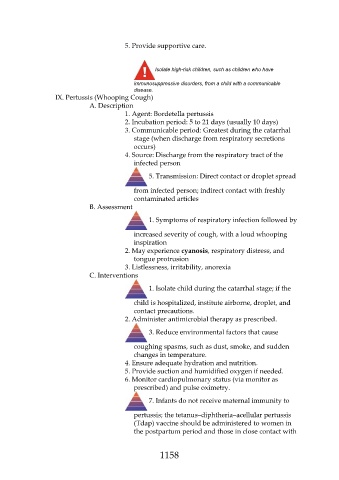Page 1158 - Saunders Comprehensive Review For NCLEX-RN
P. 1158
5. Provide supportive care.
Isolate high-risk children, such as children who have
immunosuppressive disorders, from a child with a communicable
disease.
IX. Pertussis (Whooping Cough)
A. Description
1. Agent: Bordetella pertussis
2. Incubation period: 5 to 21 days (usually 10 days)
3. Communicable period: Greatest during the catarrhal
stage (when discharge from respiratory secretions
occurs)
4. Source: Discharge from the respiratory tract of the
infected person
5. Transmission: Direct contact or droplet spread
from infected person; indirect contact with freshly
contaminated articles
B. Assessment
1. Symptoms of respiratory infection followed by
increased severity of cough, with a loud whooping
inspiration
2. May experience cyanosis, respiratory distress, and
tongue protrusion
3. Listlessness, irritability, anorexia
C. Interventions
1. Isolate child during the catarrhal stage; if the
child is hospitalized, institute airborne, droplet, and
contact precautions.
2. Administer antimicrobial therapy as prescribed.
3. Reduce environmental factors that cause
coughing spasms, such as dust, smoke, and sudden
changes in temperature.
4. Ensure adequate hydration and nutrition.
5. Provide suction and humidified oxygen if needed.
6. Monitor cardiopulmonary status (via monitor as
prescribed) and pulse oximetry.
7. Infants do not receive maternal immunity to
pertussis; the tetanus–diphtheria–acellular pertussis
(Tdap) vaccine should be administered to women in
the postpartum period and those in close contact with
1158

